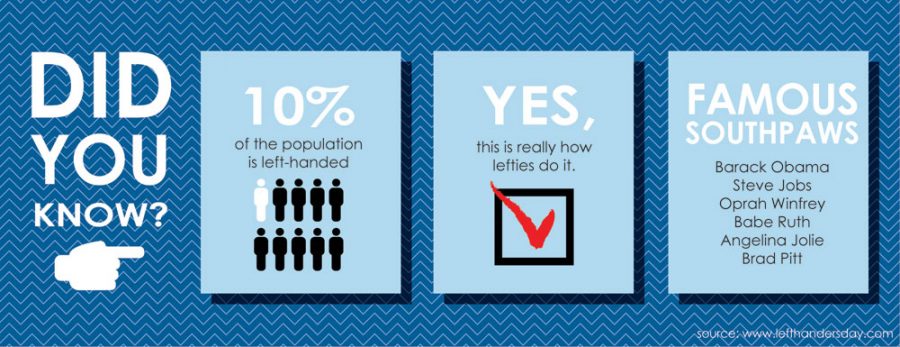While playing a light game of basketball, junior Taylor McDonald fatefully tripped over a basketball, resulting in a fracture to her left wrist. Her ill-fated accident not only handicapped the usage of an arm, but it also forced her to transition from being a natural lefty to a confined righty.
The dominance of one side of the body over the other is an ongoing curiosity for society and scientists alike. One particular branch of laterality is hand dominancy, also referred to as handedness.
This phenomenon is tied to genetic traits, William Brandler, lead researcher in genetics of handedness and cerebral asymmetry at the University of Oxford, wrote in his 2013 research article.
“There is a genetic component to handedness — hundreds of different genetic variants,” Brandler said. “Each one might push you one way or the other, along with the environment you’re in and the pressures acting on you, which affect your handedness.”
Left and right handedness is associated with two alleles: a ‘D’ gene for dextral meaning “right” and a ‘C’ gene for “chance.” The allele names speak for themselves.
“People think it’s just an environmental thing, but you’ve got to think, why is there that initial bias in the first place, and why do you see that bias across all societies?” Brandler said. “Why aren’t there societies where you see a bias to the left?”
Representing only 10 percent of the general human population, lefties have long been persecuted and labeled with impertinent stigmas from uncleanliness to association with the devil. The word “sinister” even originates from archaic terms referring to the left-hand side.
A fictional book by John H. Ritter, Choosing Up Sides, exposes this historical phenomenon. Set in the early twentieth century, protagonist Luke Bledsoe struggles with being left-handed in a prejudiced right-handed society. Bledsoe’s father, a sectarian reverend, believes that his son is a heathen and potential follower of Satan, and thus verbally and physically abuses his own son.
The plot’s conflicts arise even more when Luke accidentally finds the game of baseball by what his father calls “the devil’s playground” when he finds out that he has the ability to become an incredible southpaw pitcher.
While only a fictional plot, McDonald has been placed in the same situation as Bledsoe since the day of her injury. Temporarily forced into living the life of a righty, McDonald adapted to uncomfortable measures to presume a normal life.
“School has been hard and a little frustrating because I have to learn how to do everything with my non-dominant hand,” McDonald said. “I’m glad it’s not my elbow because I can still pick stuff up with my [left] hand, but writing with my right hand is a challenge.”
Mundane activities shifted to daily inconveniences, cutting into both her time and energy. McDonald and the rest of the left-handed community inevitably faces non-user friendly objects like school desks with built-in arm rests, can openers, spiral notebooks and scissors on a day to day basis.
“When I was little, my mom could not teach me how to use scissors because I just couldn’t understand it,” McDonald said. “I would get so frustrated because it was easy for everybody else. So one day, I sat down and spent an hour trying to cut with scissors until I figured it out.”
Contrary to scientific research, McDonald is the only member within her family to acquire such a trait.
However, junior Elliot Bones, another left-hander, has two relatives — a grandpa and cousin — who are also left-handed. Although Bones was never confined to usage of his non-dominant hand, he has experimented writing with his right hand, just to “get a feel for it.”
“Whenever I try to use my right hand, I feel pretty foolish because of its lack of coordination in comparison to my left,” Bones said. “I do find some things that are oriented towards right-handed people slightly aggravating, but I’ve kind of gotten used to it. Now I don’t pay it much attention. I just hate graphite smudges.”
Although there will always be the undeniable inconveniences of being left-handed, both Bones and McDonald alike enjoy being a part of an exclusive community where members embrace their differences and uniqueness. And since the 1900’s, society has progressively gotten more accepting towards the left-handed minority.
“I kind of like being a little different,” Bones said. “There’s a sense of community among left-handed people. If I see someone using their left hand, I talk to them and feel a bond with them — which I don’t think happens as often with right-handed people.”
By Joy Park
infographic Joy Park
Categories:
Linked together by genes, kept together by community
September 30, 2015
0
More to Discover













































































